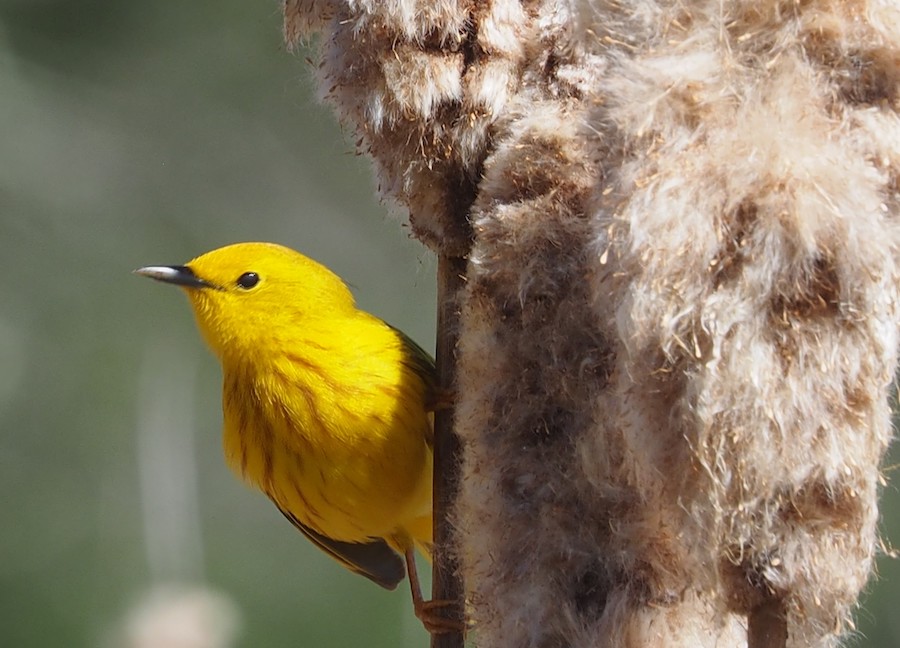
Study part of broader Bird Genoscape Project led by UCLA
An article published in January 2018 connected genetic variations in migratory songbirds with population changes due to climate change. UC Davis evolution and ecology postdoctoral scholar Rachael Bay is the lead author of the study into a songbird common throughout the Americas, the yellow warbler.
Yellow warblers prefer to live near rivers and streams, eating insects and making nests in trees. The birds can travel up to thousands of miles between wintering grounds in South America and summer breeding areas in North America, requiring adaptations to multiple types of environments to remain competitive. This study of the yellow warbler shows vulnerabilities to climate change and is an extension of a larger investigation by the Bird Genoscape Project at the Center for Tropical Research at UCLA, which is currently mapping the migratory patterns and genetic variation of many birds across the world.
“The way we extended this analysis is to ask, ‘Well, if these birds are adapted to these types of environments now, what’s that going to look like in the future?’” Bay said. “For example, if we have birds in the Central Valley that are locally adapted to the specific environment that the Central Valley has been experiencing over the last hundred years, we know that we’re getting drier and hotter here. Are those birds going to be maladapted in the future? We were able to put a number on how maladapted birds would be and look at the places across the US where this species would be more and less adapted to their future conditions.”
Areas of greatest genomic vulnerability — the mismatch between what climate the bird’s genes are adapted to and what the predicted climate will be — include areas of the Rocky Mountains and, to a lesser extent, around the Great Lakes. While evolution and genetic variation between birds has been an interest for songbird and genetic researchers for years, recent advances have allowed investigations like Bay’s to flourish.
“You could use DNA from feathers to trace the breeding origin of migrants captured anywhere along the annual cycle — from wintering areas in South and Central America to somewhere along their migratory journey,” said Kristen Ruegg, the co-director of the Bird Genoscape Project at UCLA. “We didn’t have the tools to be able to do that at the resolution that was useful for conservation and management until about five years ago.”
Genetic variation was calculated from 229 samples of yellow warbler feathers or blood by comparing the samples to the bird’s fully sequenced genome. H. Lisle Gibbs, a professor in the Department of Evolution, Ecology and Organismal Biology at Ohio State University, contributed a large amount of songbird samples from a collection his laboratory had been saving for a meaningful investigation.
“Our samples came from breeding birds at a particular site — males that were defending territories and females that tended nests — because we wanted a sample of the DNA from birds at a particular location in the environment,” Gibbs said in an email interview. “The idea was that, if there were genetic differences (genetic tags) that characterize birds from location x, then later, if birds with this tag were sampled while they were migrating or were resident on their wintering grounds, we could infer that they were from the population at location x.”
The samples were collected from 21 locations across the Western Hemisphere by university researchers, bird monitoring stations and conservation organizations.
“By knowing what genetic profile a specific population may have, we can literally track where those birds go throughout the year,” said Ryan Harrigan, an assistant adjunct professor and assistant researcher at the Center for Tropical Research at UCLA, in an email interview. “A good way to think about it is by comparing it to forensics; humans and birds alike have unique DNA signatures, and by collecting DNA from various locations, we can re-trace where those individuals have been. This is an essential part of conservation of these migratory animals, because we need to think about management strategies across their whole range (breeding, stopover, and wintering locations), and these regions often cross international borders.”
Of the 25 genetic vulnerabilities to climate change calculated, Bay’s analysis found yellow warblers were most vulnerable to changes in precipitation, followed next by changes in temperature and vegetation levels. The team hypothesizes the vulnerabilities to precipitation may be due to the songbird’s diet of insects, whose life cycles and population densities are closely linked to moisture levels.
“It seems like, for [yellow warblers], warming isn’t actually as much of an issue as precipitation,” Bay said. “For whatever reason, their genetics seem to be tightly linked to precipitation patterns. Places where precipitation will change a lot may be the hardest hit by climate change.”
The new climate vulnerability tools will help research and conservation efforts to protect birds around the world.
“It’s a proof of concept of how you can incorporate the capacity for evolution into models of climate vulnerability, which can help species that are threatened or endangered,” Ruegg said. “It can help you refine your understanding of where the greatest needs are in terms of conservation and management.”
Written by: George Ugartemendia — science@theaggie.org


